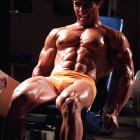 The leg extension machine is one of the most recognizable pieces of equipment in any gym. Even trainees who are rank beginners know what the exercise is and how to perform it. Its popularity dates back many decades.
The leg extension machine is one of the most recognizable pieces of equipment in any gym. Even trainees who are rank beginners know what the exercise is and how to perform it. Its popularity dates back many decades.
Many gym veterans will recall how doctors and other health-care providers maligned squats and recommended leg extensions. Squats were supposed to be “bad” for the knee. Leg extensions were supposed to be “good” for the knee. That led to leg extension machines being used in rehabilitation for knee injuries, and special types of isokinetic leg extension/leg curl machines were created that allowed only positive leg extensions and positive leg curls—that is, the lifting portion. Negatives cannot be performed on this equipment; however, that’s not the problem. The real problem with leg extensions is twofold:
1) The leg extension places maximum force on the cartilage on the back of the patella, at the thinnest portion of the cartilage. That can lead to cartilage damage. When you squat, the thickest part of the cartilage is loaded during the maximum force. Biomechanists call the squat “physiologic flexion.” Many of the doctors who decided that squats were bad and leg extensions were good allowed their own personal bias to get in the way of clinical judgment, and they did not refer to other fields like biomechanics to learn more about the motions.
2) The leg extension causes the lower-leg bone, the tibia, to move forward on the thigh bone, the femur. That stretches the anterior cruciate ligament. The squat and leg press cause the tibia to move backward on the femur. That’s due to the co-contraction of the hamstrings along with the quadriceps—and it’s a normal state. When the isokinetic machines were used in rehab and health care providers became more aware of this problem, antishear devices were placed on the machines to protect the ACL. Who knows how many ACL reconstructive surgeries were complicated by this equipment and exercise.
The leg extension caught on in gyms. All the magazines were filled with champions performing max-effort leg extensions, and some trainees followed suit. Once the patella is beaten up enough, all leg training becomes difficult. The squat was traditionally given up due to knee pain or back pain. The powerlifters and Olympic weightlifters had longer squat careers, and that may be due, in part, to the fact that they don’t perform leg extensions.
So does the leg extension belong in your workout? Not really—with an exception. If you perform heavy leg extensions, especially if the machine allows you to have even more range of motion by letting your feet go under the seat, you will place a great deal of stress on your kneecap. That could accelerate arthritic changes in your knee. Even so, one set of ultralight leg extensions can serve as a local warmup before your squats and leg presses. That’s not enough force to compress the patellar cartilage to any significance.
Many trainees have knee pain and think that if they add leg extensions, they will feel better. Your knee may feel better while it’s warmed up; however, it may ache more later in the day. If the load repeats each week and month, the aches and pains may progress. The very exercise you chose to help your knee may contribute to its ongoing pain.
So keep the leg extensions to a minimum weight and one or two sets at most. That may help knee warm up your knees before your heavy leg workout.
Train smart, then train hard.
—Joseph M. Horrigan
Editor’s note: Visit www.SoftTissueCenter.com for reprints of Horrigan’s past Sportsmedicine columns that have appeared in IRON MAN. You can order the books, Strength, Conditioning and Injury Prevention for Hockey by Joseph Horrigan, D.C., and E.J. “Doc” Kreis, D.A., and the 7-Minute Rotator Cuff Solution by Horrigan and Jerry Robinson from Home Gym Warehouse, (800) 447-0008 or at www.Home-Gym.com.




















You must be logged in to post a comment Login